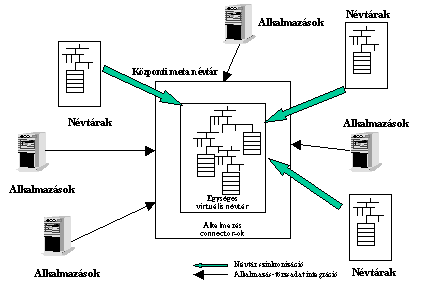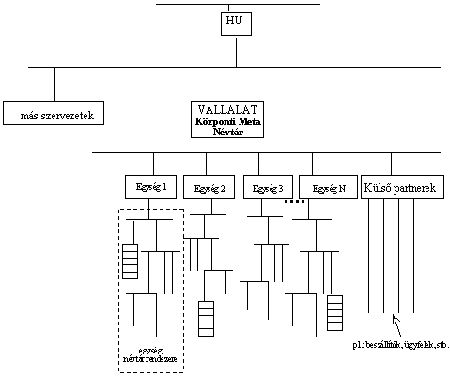| |
Directory
pages
In the companies application integration the directories plays an important role. At today's company application integration became clear that the data used by different applications need to be centralized. This kind of data could be the information about the organization's basic data, partner data, and public keys for data security. This was the main reason to create unique centralized meta folders, which could be accessed from synchronized meta applications. It is indispensable to manage and maintain the “centralized” data for the right operation of applications and mail systems. It is also important at basic data up-to-date refreshing operation.
In big companies the meta integration is one of the most important data source integration. Its importance comes by not just the electronic mailing but also the increasing of the company basic data. The meta directories needs o be accessible for mails and applications. So it is very important the centralized synchronization. It means that to put data into the directories and to reach dependently by application of the directory information could be done through central authentication system. So the directories are changing their directory information between each other. Data entry is not formatted centrally but can be done where it has been authorized and where are up-to-date data.
The PKI systems are well joined to the directory systems; the public keys and certificates are stored in the directories. The CA or RA sets the directories data as applications; the PKI User Agents are reaching this data as clients. At the creation of the PKI systems is recommended to project the form of the meta directories, because the meta directories enables other application integrations, and the efficiency of the PKI systems depends a lot on the efficiency of the meta directories. The PKI entries generally concern the company's body and partner data and the unique handling of theses data could be an advantage for other applications. The PKI application is more accessible if there is a unique meta directory in the background for the data storage.
At the creation of the meta directory you need to consider the new directory technologies, which can adapt directory synchronizations and application integrations. The tools of the directory connections are called meta connectors, which works like a program connected to the directory. The connectors perform the basic data for the meta systems (Notes, Exchange, Novell), database systems (Oracle MS-SQL) and unique applications (SAP, PeopleSoft). The meta directory technology is a new IT tool which helps on directory synchronization and gives connectors for other applications.
The
functionality of the meta directories is represented in the following
figure:
The data connection structure of the central
meta directory
The meta directories structures organize the different meta directories trees into a unified tree structure. The company directory tree structure could be managed centrally. The entries on the directory tree's branch could be setted in local relations. The unified directory trees and the access definitions for them are called meta directory synchronization. The unified, synchronized directory system allows accessing the information not just from mails but from other applications too and gives updated information for the integrated applications. The common and up-to-date personal and company data management allow synchronizing basic data applications. Also meta directory technology assures all of these with common application adaptation. From the common handling point of view application handling LDAP gets importance. The application connections enable meta directory changes from the applications. This kind of application could be a personal application or the data guarding PKI application. The meta directory handling and the use of the LDAP protocol became one of the most supported integration tool of the IT area in the last few years.
The
synchronisation of the meta systems
One of the most important tasks for the central directory system is to unify the company mail systems with directory systems. Many times there are many mailing systems inside a company and they works as different islands with the meta directories especially in cases of different mailing systems. Some mailing systems are adapted only by mailing aspect and not by complete directory handling aspect. In generally this unified mailing system invokes unified meta systems too, where the system producers don't support the directory synchronization efficiently. This is why before application integration must to do a directory synchronization, which covers the entire company's basic and partner data. This let the mailing systems to be more transparent.
The
different mail systems unique directories connects to the central
meta directory by using the connectors, but there are company applications
connected to the central directory, which has company and personal
data assured by the central directory.
The central meta directory has administration tools for directory synchronizations and application integrations and guarantees the transparency between the company's meta directories. The capacity of the central meta directory is greater than the unique systems and it optimizes their work. It integrates the existing meta directories into a unique system and the contained information became a step forward on the field of company data integration.
Company central directory planning structure is called scheme- planning. The scheme planning requires an accurate structure, which is represented in the directory's tree structure. The general tree structure of the directory is presented in the following picture:

The general structure of the centralized meta directory
The selection of the organization and personal data type needs cautiousness. At the selection of the data is important to select data types unique as it can (ex. name), and in case of compatibility a complex search should be easily separable. The cautiousness scheme planning ensures a fast functionality of the directories and increases their manageability (ex. search rate). The structured planning of registry point (entries) data means most important step of the scheme development.
Directory and application integration
At company's life needs the use of directory and application integrations comes from the common usage of the organization's and personal data. Using many applications relives that it caused problem to upload and maintain basic and partner data files systematically, and also it is problem in some cases to execute it from certain applications. When we upload basic data in all the applications we need to attend these data to stay consistent and up-to-date them. It is important to assure this consistently to up-to-date at every application, because you need a huge human and computer effort, and the errors could cause fatal effects over the company.
A working and frequently maintained meta directory could easily handle all of these problems; the data is only accessible if the data adaptation has been assured to the directory applications. The up-to-date and consistent data maintenance has become more simply due to the central and common character of the system. The central maintenance doesn't mean that all the data are introduced and maintained from a single place. The data maintenance could be done at specialized organizations, which has the authorization to upload and change certain data. The most important is that the data introducing and maintaining should be solved in a common way at the meta directory, which could access all the applications according to certificates.
The functionality of this system could be showed in the following
practical example:
On the companies level there a large variety of data about the personal, organizations, which in the most part of the applications (mail, data security (PKI), financial, workflow etc.) handles like basic data. A part of the data has been maintained by personal office, because for a specified worker they know well the needed information (ex. name, function, etc.). With employing and dismissing people they are kept informed too. It is possible to fit further information related to people or organization which can be maintained by other organizations. This kind of data could be the data security keys, certificates that another organization handle, financial identifiers – which is handled by other organization, used by the financial section, phone numbers, emails, which are all handled by other organizations. The data comes for the maintenance from many authorized places but in a common way, which are working as software modules in the application The authorization of data maintenance (who can and which data modification can be done) is ensured on company level in centralized way.
The information in the central meta directory has a tree structure. The structure of the tree shows the structure of the organization. On the branch of the tree are organizations, personal notes or associated data. The data types are following one the other, the elements data types are unified defined. The tree and data structure creation at the X.500 is standardized. The personal or organization related data elements could be changed by different applications depending on the authorization policy. The personal application ensures the tree structure and it's data. Other application could provide data security keys, mail addresses etc.
The uploaded maintained common data is made by the application using the connectors. This is very important data integration for the company and ensures the daily update of these data.
In the example presented above the PKI public keys and certificates could connect in a central maintained data structures. The PKI application updates the public data and certificates into the meta directories and in this way will be possible for other applications to use these keys.
| | |



